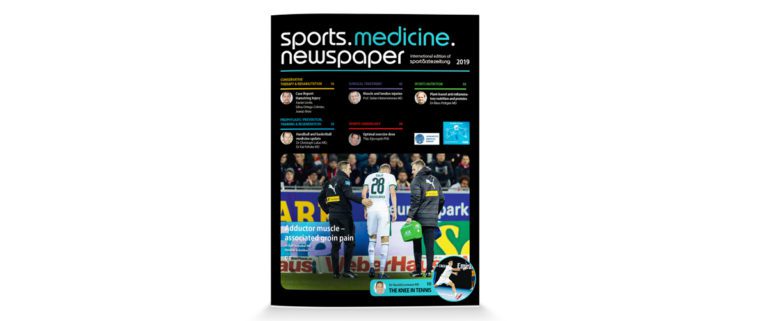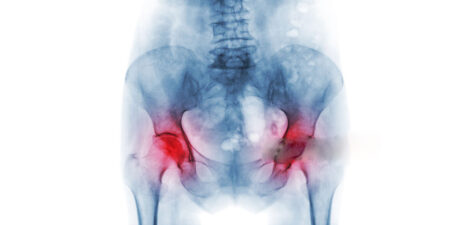Patients presenting with cartilage damage of one sort or another are a common everyday occurrence at the practices of sports medicine physicians. As far back as 1760, the Scottish anatomist William Hunter observed that “hyaline cartilage does not heal”. This insight is still true today and shapes the treatment routine of all orthopaedists and sports medicine physicians and of many patients. Due to the high, multi-directional loads placed on joints and repetitive trauma, athletes often begin to suffer from arthritis in important weight-bearing joints at a comparatively early age. Since no cartilage-healing substance has yet been found, hyaluronic acid, in use for many decades, is still highly valued in the treatment of cartilage lesions. This explains why hyaluronic acid also suddenly became a topic of discussion at the expert meeting in Bad Nauheim when the subject of arthritis and inflammation management was being discussed (see above). The different ways in which it is applied were interesting and were the reason for this small digression about hyaluronic acid. Is a single injection better than multiple injections? Do you combine hyaluronic acid with a local anaesthetic or a corticosteroid? These questions led to animated discussion among experienced users.
What is hyaluronic acid?
Hyaluronic acid is a polysaccharide occurring naturally in connective tissue. A special characteristic of hyaluronic acid is its capacity to bind large amounts of water. In joints, it is a principle constituent of synovial fluid and acts as a lubricant, specifically by adjusting its viscosity to the forces acting on it mechanically. It adheres to the joint cartilage in a chemical interaction and is not squeezed out of the joint space under loading, as is often assumed. It also plays a role in regenerative processes in that it widens the intercellular space and thus improves the migration of cells. This is very useful as a chemical property, for example postoperatively in microfracturing.
Hyaluronic acid? ‒ It doesn’t matter which kind of hyaluronic acid you use; it all comes from the same source!
The opinion frequently held by doctors that the hyaluronic acid supplied by different providers is all produced by only one manufacturer (comes from the same source) is incorrect. There are approx. 10 manufacturers globally that produce the raw material. The products do, however, vary in quality, especially in terms of stability. This means that some hyaluronic acid products lose their viscosity after prolonged storage. It is assumed that this has something to do with a barely measurable impurity in the raw material. This is not something the individual doctor can readily check. It is therefore advisable not to store hyaluronic acid products for too long and, if possible, to choose products where the raw material has not been produced in Asia, as these products are likely to be the most unstable.
Does hyaluronic acid really work?
Intra-articular and peritendinous administration of hyaluronic acid is effective. Its efficacy has been demonstrated both for the indication arthritis (e.g. B. Miltner et al. 2012, Petrella et al. 2006) and meniscopathy (e.g. Dernek et al. 2017) and not least for tendinopathy as well (N.Lynen 2012, 40 mg hyaluronic acid and 10 mg mannitol ((Ostenil Tendon)), Gorelick et al. 2015). There are differences particularly regarding its duration of effect. It has been statistically shown that hyaluronic injections can significantly delay the time until endoprosthetic treatment of the knee becomes necessary (Altmann et al. 2015). Proof of efficacy consequently resulted in the inclusion of intra-articular hyaluronic acid therapy in the AWMF [Association of the Scientific Medical Societies in Germany] guideline on arthritis of the knee.
What hyaluronic acid should you use?
Opinions differ sharply on this issue. The differences in quality mentioned above are hard for a treating physician to check. It is equally hard to decide whether to opt for a linear or cross-linked hyaluronic acid or a hyaluronic acid with a high or low molecular weight. There are studies on this issue, but they are often initiated and funded by the manufacturers. It is difficult to find clear answers. A study on a rat model showed that linear hyaluronic acid with an intermediate molecular weight increased cartilage elasticity the most (Gaumet, Badout, Ammann Genf 2018). However, relatively good elasticity values were also achieved in the same study with high-molecular weight cross-linked hyaluronic acid. An important issue to consider is the frequency of injection. With a single administration, the risk of infection from the injection is naturally lower than with an administration given 3 – 5 times. A study by Bannuru et al. in 2015 showed no significant difference in the efficacy or duration of effect between the 5-times administration of hyaluronic acid and the single administration of two products from the same manufacturer. The duration of effect of both products was approx. 6 months. This is also consistent with users‘ current clinical experience.

Should you combine hyaluronic acid with other substances?
This subject was also a matter of very intense debate at the expert meeting in Bad Nauheim. Some users administer local anaesthetics and/or corticosteroids in combination with hyaluronic acid products. A number of studies (Bulstra et al. 1994, Gulihar A. et al. 2013, Farkas B. et al. 2010) have shown that both local anaesthetics, e.g. lidocaine, and corticosteroids, e.g. betamethasone, lead to the death of cartilage cells. In view of the study data, use of local anaesthetics should be very selective. Use of intra-articular corticosteroids should also be considered carefully based on the risk profile. Routine administration in combination with hyaluronic acid is certainly not appropriate. However, there is agreement that hyaluronic acid should not be used to treat an inflamed knee with synovialitis and effusion. In such cases, single administration of corticosteroids is useful. There is high consensus on this procedure in the AWMF guideline on arthritis of the knee under item 4.1.2. At the same time, mention is also made that high-dose corticosteroids can inhibit cartilage cell metabolism and thus damage the cartilage (Hirsch at al. 2013).
Is hyaluronic acid still the gold standard?
Intra-articular hyaluronic acid products have been available for many years and, based on the current study data, are still one of the most important options for the symptomatic treatment of arthritis. A significant effect cannot, of course, be achieved in every patient. And not every patient will experience a lasting effect. However, in routine clinical practice it is important to have a useful option available for symptomatic relief in patients with arthritis that does not yet require surgery. Professional athletes with meniscopathy, for example, can also be helped in this way, as it allows surgical repair of the meniscus to be postponed until the end of the season. Due to the different mechanisms of action, the combined use of hyaluronic acid and platelet-rich plasma is also an increasingly popular option. There is still a lack of valid studies on this. From what was generally said at the expert meeting on arthritis and inflammation management in Bad Nauheim, , the combined use of intra-articular hyaluronic acid and oral UC-II®, i.e. a combination of improved cartilage nutrition and an immunological approach, may be of prospective interest.
Interim conclusion
The administration of intra-articular hyaluronic acid has been and still is an important pillar of the medicinal treatment of arthritis. Our personal experience over the last 20 years tends to favour the 3-5-times administration in a weekly rhythm. The impression of a somewhat higher sustained effect compared to single administration commends multiple administration. However, in elderly and immunosuppressed patients single administration with strict indication is the better option. The variety of the individual hyaluronic products in terms of molecular weight and cross-linking makes comparison difficult. The data available is sometimes inadequate. The user must have confidence in the manufacturers when selecting which product to use. Reputable manufacturers will always be transparent about where the product was produced and filled.
Part II
What is UC-II®?
UC-II® brand is protected by trademark registrations globally covering the proprietary ingredient product which contains undenatured type II collagen. This collagen was harvested by a chemist from chicken sternum. What is special here is that the collagen is not harvested by heating or hydrolysis, which would result in the collagen being denatured and losing its efficacy. This substance is now harvested by a Swiss company (production site in the USA) using a special patented process and is marketed in different oral pharmaceutical forms. Its mechanism of action is interesting as it does not involve high concentrations of a substance that is a structural component of cartilage being present in the joints on oral intake. The effect is thought to arise through the development of oral tolerance due to an interaction between UC-II® and the immune cells in Peyer’s patches in the small intestine. The regulator T-cells formed during this interaction can produce anti-inflammatory cytokines in the joints. These in turn can have a symptom-modulating and repair effect on the joints. A number of studies (Lugo, Saiyed, Lane, Nutrition journal ((2016)), Bagi, Berryman, Lane Osteoarthritis and Cartilage ((2017)) corroborate this propagated effect on rat models and in placebo-controlled trials*. As with hyaluronic acid, which was used at an early stage in veterinary medicine, e.g. in equestrian sport, UC-II® has already been adopted in today’s veterinary practice. It can be considered as a new approach that offers us support in helping our athletes, who often suffer from arthritic changes in their joints early on in their lives. Even if the currently available data for the relatively new substance UC-II® is still limited, the studies have been promising and we will follow and monitor further developments with interest.
*a placebo-controlled, randomised, double-blind study in humans in 2016 showed that UC-II® undenatured type II collagen can improve the well-being, mobility and flexibility of the joints of individuals with OA. It was statistically far more effective than a combination of 1.5 g glucosamine and 1.2 g chondroitin, according to the WOMAC index (Western Ontario and McMaster Universities Osteoarthritis Index).
Autoren
ist Facharzt für Orthopädie und Inhaber einer orthopädischen Praxis mit Schwerpunkt Sport-Orthopädie in Münster. Außerdem ist er Vereinsarzt des SC Preußen Münster, Mannschaftsarzt der U16 DFB-Nationalmannschaft und wiss. Beirat der sportärztezeitung.



